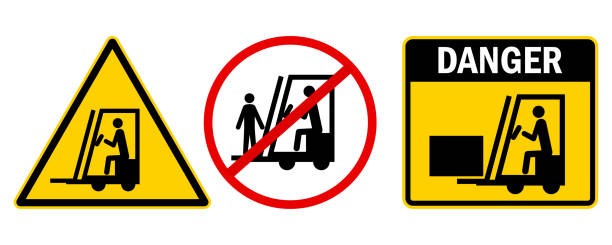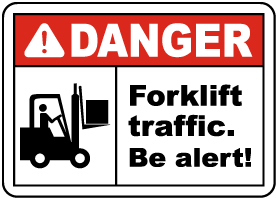Comprehensive Overview of Forklift Truck Safety Indicators and Their Influence On Safety And Security Society
The assimilation of forklift truck safety and security indications within operational environments is essential fit a company's safety culture. These indicators not only interact vital cautions and procedures yet also serve as a consistent pointer of the common responsibility for work environment safety. By examining various sorts of security signs and their critical placement, one can reveal the nuanced ways they influence employee actions and understandings of risk. As we check out these dimensions, it comes to be apparent that the implications expand beyond plain compliance, welcoming a much deeper query into their long lasting influence on safety and security practices and business values.
Importance of Safety Signs
Safety indications play a crucial role in maintaining functional efficiency and ensuring the well-being of employees in environments where forklift vehicles are utilized. These signs act as vital communication tools that share essential information concerning possible dangers, operational treatments, and safety and security procedures. By plainly marking areas where forklift procedures are common, safety indicators aid to decrease the risk of crashes and injuries.
In high-traffic atmospheres, such as storehouses and warehouse, the existence of security signs properly overviews both operators and pedestrians, advertising understanding of their surroundings. This enhanced understanding is important for avoiding collisions and ensuring that people adhere to established safety and security steps. Furthermore, safety and security indications can reinforce training programs by giving aesthetic pointers of safe techniques and procedures.
The application of properly designed security indicators also adds to cultivating a culture of safety and security within the workplace. When workers observe and value these signs, it grows a shared responsibility for preserving a secure environment. Eventually, the relevance of safety indications expands beyond simple conformity; they are integral to establishing an aggressive safety frame of mind that focuses on the health and wellness and safety and security of all personnel associated with forklift operations.
Types of Forklift Safety Signs
Effective communication of safety information is paramount in environments where forklift vehicles run, and numerous kinds of safety and security indications play a crucial duty in this interaction. Forklift Truck Safety Signs. These indicators are made to share critical safety directions, warnings, and info promptly and efficiently, guaranteeing that all employees understand possible threats and risk-free operating procedures
The main sorts of forklift safety signs include cautioning signs, which sharp employees to prospective dangers such as overhanging lots or unsteady surfaces; restriction indicators, which suggest activities that are not enabled, such as unauthorized employees in forklift operating areas; and compulsory indications, which specify needed actions, such as putting on personal protective devices. Additionally, details indications give crucial details concerning operational treatments, while directional signs lead workers securely around the worksite.
Each indicator type is characterized by standardized shades and signs, enhancing presence and comprehension. By employing these diverse indication kinds, companies can create an extensive safety and security interaction system that promotes a society of safety and security and awareness amongst all employees. This positive strategy not just aids minimize crashes however additionally contributes to a much more reliable and responsible workplace atmosphere.

Design Principles for Effectiveness
Developing impactful forklift security indications requires adherence to numerous layout concepts that improve their effectiveness. Indicators have to communicate messages in easy, direct language, utilizing globally recognized icons.
Shade choice plays an important duty in indication design. High-contrast shades, such as yellow for caution and go to my blog red for threat, must be employed to attract interest and indicate necessity. Additionally, the dimension and go exposure of the sign are crucial; they need to be large sufficient to be seen from a distance, ensuring that drivers have adequate time to react to the details provided.
Integrating comments from workers throughout the layout procedure can boost the indicator's relevance and acceptance, promoting an aggressive safety and security society. By adhering to these concepts, companies can make certain that forklift safety and security indicators effectively connect essential safety information, eventually contributing to a much safer work atmosphere.
Strategic Placement of Signs

It is also necessary to think about the elevation and angle of the signs to prevent blockages and guarantee readability from different distances. Indications need to be placed at eye level when feasible, and reflective products can enhance exposure in low-light problems. Furthermore, using a combination of fixed and dynamic signs, such as digital display screens that can pass on real-time information, might better enhance awareness.

Measuring Effect On Safety And Security Culture
Assessing the influence of forklift security signs on safety society includes a methodical method to collect original site and examine appropriate data. This analysis begins with establishing baseline safety and security metrics before the application of security signs. Trick performance indicators (KPIs) such as case prices, near-miss reports, and employee responses must be recorded to help with contrast post-implementation.
Subsequently, a longitudinal study can be performed to keep an eye on changes in security actions and attitudes gradually. Surveys and surveys can be dispersed to employees to assess their recognition and understanding of safety signs, along with their perceptions of the work environment safety and security society. This qualitative data can match measurable metrics, providing an alternative sight of the adjustments attributable to the signage.
Additionally, routine safety and security audits can be performed to evaluate conformity with the signs, guaranteeing that the indications are not just existing yet also efficiently incorporated right into day-to-day operational workflows. Examining information accumulated from these audits can reveal patterns and locations for improvement, eventually allowing companies to fine-tune their safety and security strategies. By measuring the impact of security indicators, companies can promote an aggressive safety culture that prioritizes employee wellness and functional performance.
Final Thought
In final thought, forklift vehicle security indications are crucial parts of office safety and security society, successfully interacting dangers and needed preventative measures - Forklift Truck Safety Signs. Their numerous kinds, clear layout concepts, and tactical placement dramatically boost presence and comprehension, promoting understanding in high-traffic areas. By promoting a collective responsibility for security and on a regular basis examining their efficiency, organizations can cultivate an aggressive safety and security society, inevitably leading to a decrease in crashes and injuries, consequently guaranteeing a safer working setting for all workers